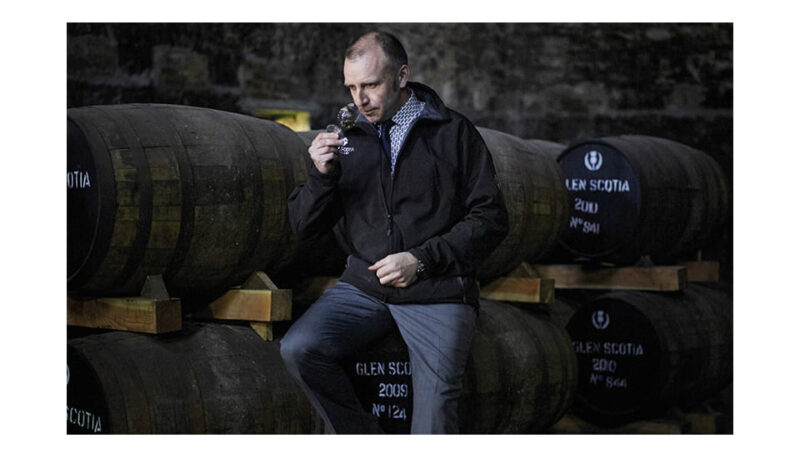
Glen Scotia is one of only three distilleries in Campeltown, and one of Scotland’s smallest. We at Wild about Whisky have a long-standing affinity to Glen Scotia’s malt, so out ever-curious whisky-lass, Juliette Venter, caught up with master distiller and distillery manager Iain McAlister, and fired a few questions at him…

“With Glen Scotia think of a perfect nose, light oily balance, elegant yet flavoursome.
Spicy, rich notes come through also, with a slight salty finish. “
JV: Tell us about yourself!
IM: I am the Distillery Manager at Glen Scotia Distillery in Campbeltown. I have held this position for over 10 years and I was lucky enough to be born in Campbeltown itself. My previous background was engineering.
JV: Can you give us a brief history of Campbeltown and the distilleries that use to operate in the area?
IM: Campbeltown used to be the most important whisky region in Scotland, the area’s economy has long relied on fishing and farming although Campbeltown has a reputation as a producer of some of the world’s finest malt whisky. The Scotch Whisky Regulations 2009 defines Campbeltown as one of two protected localities, the other being Islay. Campbeltown Single Malts are single Scotch malt whiskies distilled in the burgh of Campbeltown. Once a major producer with over twenty distilleries and claiming the title “whisky capital of the world”, production has markedly declined with the majority of these distilleries now closed and out of business. Ten distilleries failed in the 19th century while a further seventeen distilleries closed between 1920 and 1935. The three distilleries producing in Campbeltown today are Springbank, Glengyle and Glen Scotia distillery. Springbank and Glengyle are owned and operated by J & A Mitchell & Co. Ltd, while Glen Scotia is owned and operated by the Loch Lomond Group. As mentioned, Campbeltown is the very epitome of the whisky industry in Scotland, with such a rich and unrivaled history that was the epicentre of the art of whisky making in the Victorian era. This provenance gave Campbeltown distinctive descriptors that imbued certain styles for the three remaining distilleries in Campbeltown, which all have maritime influences: light salt brine, subtle oils and, depending on the method of production, delicate smoky influences.
JV: Can you give us a little history on Glen Scotia?
IM: Glen Scotia Distillery has a rich vein of both historical and production records, which allowed us to look into the Victorian era of whisky making in Campbeltown. These records combined with our present production techniques, which still use equipment that is traditional and well suited to matching whisky that was produced well over a century ago, in the very same spot since 1832 – fantastic! The style of Glen Scotia has a maritime influence with subtle oils and saltiness. With Glen Scotia think of a perfect nose, light oily balance, elegant yet flavoursome. Spicy, rich notes come through also, with a slight salty finish.
JV: What does it take to be a Master Distiller?
IM: The best job in the world! To be honest you have to be a very organised, diligent and dedicated person to be a master distiller, especially when you are also a Distillery Manager. You must be able to juggle a lot of different tasks, be able to make quick decisions and have the ability to tailor how you deal with directors and customers alike, so very interesting…the whisky ah yes! Well you need to have an eye (or nose) for a flavour profile!
JV: Worst part and best part of being a Master Distiller?
IM: I can’t say there is a bad part, but the best part for me is the enthusiasm shown by all friends and visitors to the distillery, this makes the job so rewarding and worthwhile. I started at GS when we had one bottling in the core range and three members of staff, so getting the chance to show how the distillery has developed, to all our visitors, is simply amazing for me. Similarly getting recognition for the new core range is fantastic!

JV: What is the distillery’s current capacity and how many stills do you have?
IM: Glen Scotia Distillery has a maximum capacity of circa 700,000 litres – 24/7. I work a shift system Monday to Friday 24/7 & a day-shift Friday & Saturday distillation only, producing over 500,000 litres with five operators – Mashman & Stillman.
We have two stills at Glen Scotia Distillery – a Wash Still (11800 litres) and a Low Wines and Feints Still (8400 litres) – the spirit still is also known as the “Spirit Still” and the “Wee Still”.
JV: Do you do your own malting and drying?
IM: No, all my malted barley comes from the east coast of Scotland, from a small town called Montrose. I have spent the last ten years working with the maltster, who has provided me with the finest barley, from the best growing area in Scotland. Starting with great quality ingredients will allow the production of superb quality new make spirit!
JV: Where does Glen Scotia Distillery get its salty character from?
IM: Very good question! Partly from the sodium content of the malted barley and partly from the maturation process and the clean crisp Atlantic coastal breeze. The warehousing buildings all are at the mercy of the prevailing weather conditions and this interaction allows for the unique Campbeltown flavour profile.
JV: Do you like experimenting with different cultivars of barley and yeast?

IM: Going back a few years this was my main focus in the distillery, I was trying to stabilise our production regime, which at the time was three mashes a week! I have experimented with dried and pressed yeasts, moved from Optic to Concerto barley variety and of course undertook many different peating levels.
JV: Do you enjoy peated whiskies?
IM: Yes, I love peated whiskies, some are great because they are the embodiment of the region in question – very bold and robust. Alternatively, some peated whiskies are fantastic because they have such a balanced flavour from the distillery in question and produce some of the best whiskies in the world.
JV: Best and worse whisky you have tasted?
IM: I don’t think I have tasted a bad whisky! But I have certainly tasted a few fantastic whiskies my current favourite is a rather nice 1989 Glen Scotia second fill sherry hogshead, which is situated within our dunnage warehouse. This had a rich well-developed nose – leather, walnut, lemon etc, with a beautiful mix of ripe tropical fruits on the palate; oily and subtle salt, rather nice!
JV: What does the future hold for Glen Scotia?
IM: We are incredibly busy at present and have come a long way in the last few years – 80,000l/annum to over 500,000l/annum and employees from 3 to 9, so this tells a story, one of unprecedented growth and expansion, long may it continue!
We wish Iain and Glen Scotia every success!

